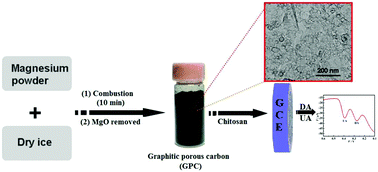Graphitic porous carbon: efficient synthesis by a combustion method and application as a highly selective biosensor
Abstract
Graphitic porous carbon (GPC) was simply synthesized by a combustion method, in which dry ice was used as the carbon source and magnesium powder was used as the reductant. The whole combustion procedure only took about 10 min without any sophisticated equipment or toxic and corrosive reagents, demonstrating high energy, material, and labour efficiency. The GPC was characterized by powder X-ray diffraction, transmission electron microscopy, nitrogen sorption analysis, and Raman spectroscopy, and the results showed that the obtained GPC had a high degree of graphitization and a high surface area (the surface area and total pore volume of the GPC were 414.87 m2 g−1 and 1.03 cm3 g−1, respectively). Benefitting from high graphitization, the prepared GPC demonstrated high conductivity for simultaneous determination of dopamine and uric acid with the detection limits of 8.0 nM and 30.0 nM, respectively. Owing to the high efficiency of this method, it may potentially be applied on the scale of industrial production.



 Please wait while we load your content...
Please wait while we load your content...